![]() Want to connect more with your target audience?
Want to connect more with your target audience?
Thanks for reading this post and Brass Ring also thanks those whose content is shared here on our website. We present it in order to pass on their knowledge to our small business clients so it can help them remain informed, healthy and growing their businesses. Please bookmark our site, subscribe to our newsletter and come back for more marketing, small business & WordPress tips, advice, tools & news! - Edward A. Sanchez
Wondering how to deliver relevant social media content consistently?
Planning your social media content delivery keeps your marketing on-message, making it more likely that you’ll reach your business goals.
In this article, you’ll discover how to create a social media marketing content plan for your business.
By Warren Knight (You can read the entire article HERE on Social Media Examiner’s website.)
![]()
#1: Understand How Your Ideal Customer Moves From Awareness to Conversion
Whether you’ve been in business for 24 hours or 10 years, defining your target customer is a crucial part of your journey. You may be thinking it’s easy to define your target customer based on the usual demographics, age, gender, etc.
However, you need to go beyond simply identifying your target customer’s marital status, where they live, or what their hobbies are. In the era of the “experience,” you have to give your customers an experience they’ll fall in love with. For example, Uber and Airbnb have grown to be successful companies because they provide a great customer experience while fulfilling a need.
Put yourself in your target customers’ shoes. What is their first thought when researching a product? How do they progress from there? Most importantly, what’s the final question they ask before making a purchase? To better understand this exercise, let’s analyze two hypothetical target customers: Rita and John.
Rita is a creative entrepreneur and visual in her approach to business and lifestyle. She’s passionate and inquisitive, always asking questions before making a decision to buy a product or service. She calls her friends on the phone, and searches with Google and through social media. Rita’s way of finding answers is through a Pinterest infographic or an Instagram post.
Here’s how you might identify Rita’s thought process when purchasing a product or service.
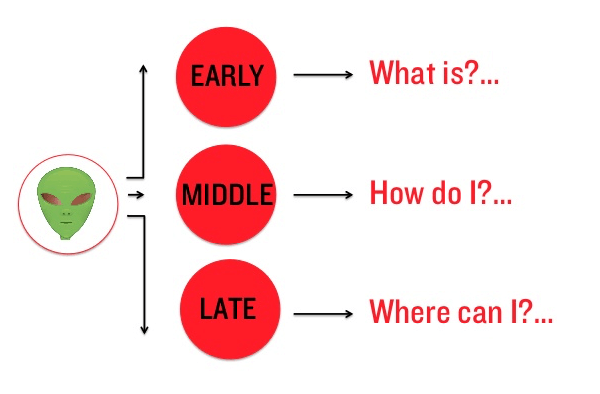
Outline the purchase process for your first target customer.
John is more analytical and methodical when it comes to a home and work/life balance. He’s more interested in facts and figures than Rita, but like Rita, he talks to his friends and uses Google to gather information. He prefers LinkedIn’s more B2B approach to getting answers to his questions.
Here’s how you might identify John’s approach to purchasing a product or service.
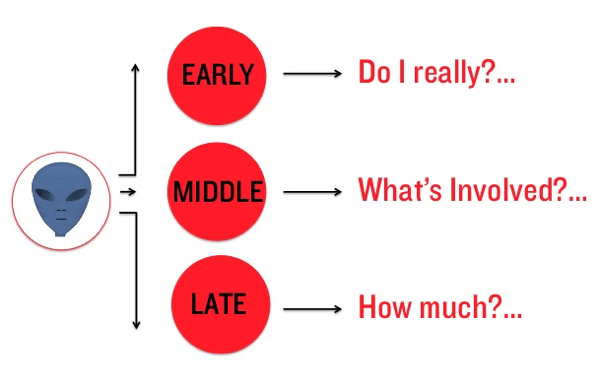
Outline the purchase process for your second target customer.
The three stages in the customer acquisition journey are always the same but with a different human approach. Your ideal customers are asking different questions, and your business can build trust by answering their questions and providing valuable content in the form of blog posts, images, infographics, and webinars.
By taking the time to understand how your target customer thinks, you’ll better understand what content will resonate with them and how you can earn their trust.
#2: Decide Why You’ll Use Social Media for Business, and Identify KPIs
Defining a goal for your social media efforts is crucial. Without a goal, you can’t assess the success or failure of your plan. Let’s look at three potential goals you may have and how to measure them.
Build a Community
Suppose you’ve spent 12 months building a closed community of people who have engaged with you and bought your product or service. You’ve grown a private Facebook group to 350 members, and while this may not seem like a lot (considering you have a database of 17,000+ email addresses), the group is by invitation only and full of nurtured customers.
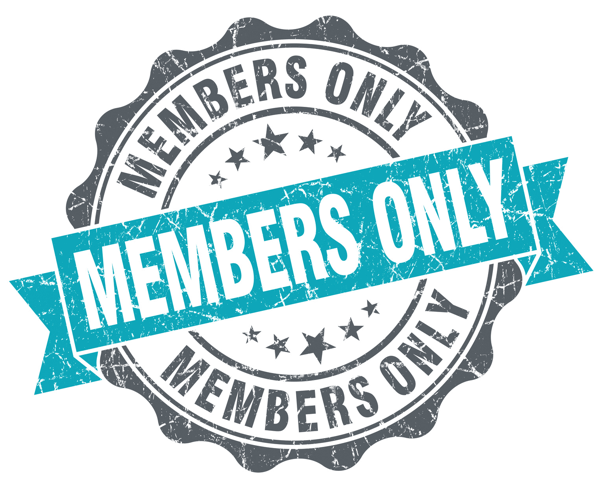
Members in your Facebook group are more important than the fans on your Facebook page because they’re engaging with you every day.
Here are the metrics you can measure when looking at the growth of this specific community:
- Number of group members
- Engagement on your live videos
- Engagement on your daily posts
- Questions your group is asking
Unfortunately, Facebook’s analytics don’t offer much in the way of solid statistics for private Facebook groups, so consider using a third-party tool like Grytics.
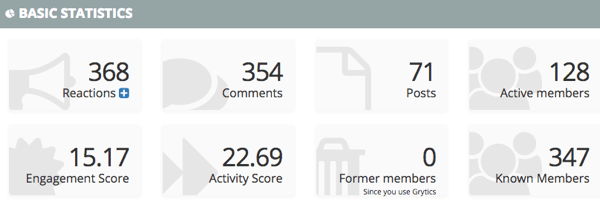
Grytics provides a variety of stats for Facebook groups.
Increase Brand Awareness
The biggest reason marketers use social media is to build brand awareness. The average person will spend close to two hours a day on social media, which is why brand awareness is a key goal for businesses.
Suppose Twitter is your network of choice. You could analyze the following metrics to assess brand awareness:
- Follower count
- Impressions
- Mention and shares
- Top tweet (to help you understand what your audience engages with the most)
- Top mention
- Profile visits
- New followers
You can find this data in Twitter Analytics.
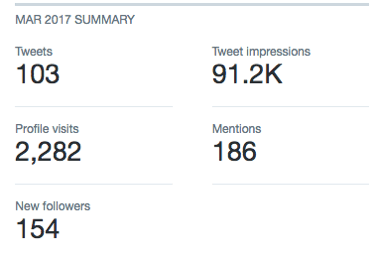
You can find relevant Twitter stats in Twitter Analytics.
Boost Engagement
Engagement is the second most important metric businesses use to measure social media success. Boosting engagement helps you build brand trust, recommendations, and perception online. Engagement is particularly important on Facebook and Instagram because they prioritize posts with higher engagement, showing them in the feed before posts with less engagement.
Analyze engagement measures similar to those discussed above. In addition, take a closer look at the number of community members who reach out to you on a daily basis through retweets, likes, questions, and any other communication.
Leave a Reply
You must be logged in to post a comment.